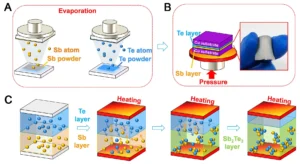In today’s tech-driven world, random access memory (RAM) is an essential component in almost every computing device, from smartphones to high-performance servers. It acts as temporary, high-speed memory that enables a device to access and store data quickly. But as technology advances and new challenges arise in terms of performance, energy consumption, and scalability, researchers and engineers are turning their attention to next-generation memory technologies.
One such technology gaining significant attention is Resistive Random-Access Memory (ReRAM), also known as memristor-based memory. While traditional RAM (like DRAM and SRAM) has served us well for decades, ReRAM promises to revolutionize memory storage in the coming years, making it a contender for replacing or complementing current memory technologies. In this blog, we will explore why ReRAM is emerging as a disruptive force in the world of memory technology, and why it has the potential to surpass conventional RAM in specific use cases.
1. Understanding the Basics of ReRAM
Before diving into the reasons why ReRAM is considered the next big thing, it’s important to understand what ReRAM is and how it differs from traditional RAM.
ReRAM is a type of non-volatile memory that operates by storing data through resistance changes in a material, typically a metal oxide. The core concept behind ReRAM is the use of a memristor, a two-terminal device whose resistance can be modified and retained even when the power is turned off. Unlike DRAM and SRAM, which are volatile and lose data when power is removed, ReRAM retains its data without requiring constant power supply.
The primary mechanism of ReRAM involves the use of electrical pulses to switch the resistance of a material between a high-resistance state (HRS) and a low-resistance state (LRS). These resistance states represent binary data (0s and 1s). ReRAM’s simple and scalable design enables the possibility of storing data with lower power consumption and greater density than traditional memory.
2. Why Is ReRAM Emerging?
Although traditional RAM, such as DRAM and SRAM, has served as the backbone of modern computing, there are several challenges that limit its scalability and efficiency. ReRAM has the potential to address these challenges, which is why it is quickly emerging as a promising technology.
2.1. Non-Volatility: Power Efficiency
One of the main advantages of ReRAM over traditional volatile memory is its non-volatile nature. While DRAM requires a constant supply of power to retain data, ReRAM can store information even after the device is powered off. This makes ReRAM ideal for applications where low power consumption is crucial, such as in battery-operated devices, edge computing, and mobile technologies.
By removing the need to refresh memory constantly, ReRAM can achieve significant power savings. This can result in longer battery life for mobile devices, reduced energy consumption in data centres, and lower heat generation in systems. Moreover, as energy efficiency becomes more important in an increasingly environmentally-conscious world, ReRAM’s low-power features make it an attractive alternative to traditional RAM.
2.2. High-Speed Performance
Traditional DRAM memory is often limited by its relatively slower write speeds due to the need to refresh data constantly. ReRAM, on the other hand, offers faster write and read operations because of its direct electrical resistance switching mechanism. It can perform data writes much faster than current NAND flash memory and consumes less power in the process.
In addition, ReRAM can achieve high-density memory configurations without a significant performance penalty. For applications that require both fast access and high storage density, such as high-performance computing and artificial intelligence (AI), ReRAM could emerge as the perfect solution to break through the performance limitations of current memory technologies.
2.3. Scalability: Dense Memory
As Moore’s Law begins to slow down and the miniaturization of semiconductor devices faces physical limitations, there is increasing interest in developing memory technologies that can scale to higher densities without compromising performance. ReRAM has a highly scalable design that allows for smaller cells with higher storage capacities than conventional memory.
ReRAM can theoretically provide better scaling efficiency than DRAM or NAND flash, which face challenges such as leakage currents and increased complexity at smaller nodes. This ability to scale more effectively is important for future applications, including high-density storage systems, large AI models, and next-generation mobile devices.
2.4. Durability and Longevity
Flash-based memory, such as NAND flash, has a limited number of write cycles before it begins to wear out. In contrast, ReRAM is less prone to degradation over time. It can endure millions of write cycles without significant performance loss, making it more durable and suitable for high-endurance applications. This quality of ReRAM makes it particularly beneficial for industrial and enterprise storage solutions, where reliability and long-term performance are key requirements.
The durability and reliability of ReRAM make it an ideal candidate for use in applications where memory wear is a concern, such as in automotive electronics, embedded systems, and mission-critical infrastructure.
3. Applications of ReRAM
ReRAM holds great potential for a variety of applications, especially in industries that require both performance and storage capacity improvements. Here are some of the major areas where ReRAM is expected to make a significant impact:
- Edge Computing & IoT: Devices in edge computing and the Internet of Things (IoT) often require small, low-power, and highly efficient memory solutions. ReRAM, with its non-volatility and low energy consumption, can be used in these applications to provide efficient data storage and retrieval without compromising battery life or performance.
- Artificial Intelligence & Machine Learning: AI and ML models require vast amounts of data to be processed quickly and efficiently. ReRAM can improve the speed of these processes due to its high-speed data write and read capabilities, making it a crucial component in next-generation AI hardware.
- Data Centers & Cloud Storage: Data centers and cloud services demand high-density storage solutions with low power consumption. ReRAM could reduce the reliance on traditional disk drives and NAND flash storage, leading to improved performance and energy efficiency.
- Consumer Electronics: ReRAM could replace traditional NAND flash memory in smartphones, wearables, and other consumer electronics. It offers faster performance, greater energy efficiency, and better durability compared to existing storage solutions.
4. Challenges Facing ReRAM
While ReRAM holds great promise, there are still challenges to overcome before it can be widely adopted. These include:
- Manufacturing Complexity: The production of ReRAM devices is still in the early stages. Manufacturing ReRAM on a large scale at reasonable costs requires overcoming various technical challenges related to material selection, fabrication techniques, and integration with other semiconductor components.
- Standardization: Unlike DRAM and SRAM, ReRAM is still in the research and development phase for many applications. The industry lacks a unified standard for ReRAM, which could delay its adoption in commercial products.
- Integration with Existing Systems: ReRAM needs to be integrated into current computing systems, which may involve compatibility challenges with existing architectures, controllers, and software. This integration will require significant time and effort to make ReRAM an effective drop-in replacement for traditional memory.
Conclusion
Despite the widespread use of traditional RAM technologies like DRAM and SRAM, ReRAM represents a highly promising new frontier in memory technology. Its non-volatile nature, high speed, low power consumption, scalability, and durability offer solutions to many of the limitations faced by conventional memory technologies. As research progresses and manufacturing techniques improve, ReRAM could soon become a mainstream option in many fields, ranging from consumer electronics to enterprise storage and AI applications.
While ReRAM is not likely to replace traditional RAM entirely in the immediate future, it could complement existing memory technologies and gradually take over specific use cases that demand higher performance, energy efficiency, and durability. The future of computing could very well include both DRAM and ReRAM, working side-by-side to address different memory needs.
As we look forward to the next decade of computing, ReRAM stands as one of the most exciting and transformative technologies that could reshape the way we think about memory storage and data processing. The future is truly resistive, and it’s poised to be a game-changer in the memory technology space.




